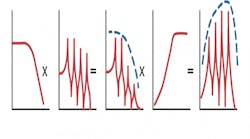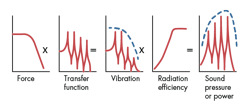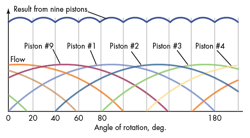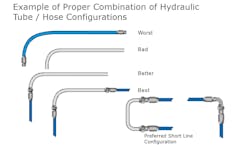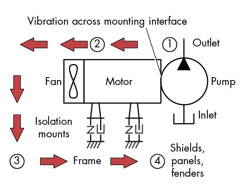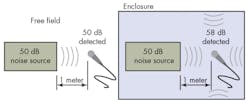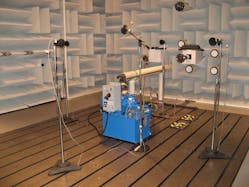*Editor's Note: This article was updated in November 2022.
The National Institutes of Health estimate that 15% of Americans between the ages of 20 and 69 have suffered hearing loss — mostly permanent — due to exposure to noise at work or in leisure activities. At the workplace, the combination of a quiet pump, well-engineered vibration and pulsation controls, and good, economical installation practices will result in a product with a distinct advantage in the marketplace.
Sound is formed by vibrations that create an audible mechanical wave of pressure through a medium, usually air or water. In hydraulics, noise can be grouped into three categories:
- airborne noise, which travels from the air to the ear
- fluid-borne noise, which is transmitted through the hydraulic system
- structure-borne noise, which is created when one component of a system propagates vibration through another component.
The factors that influence noise generation are summarized in Figure 1 (below). Unfortunately, people often reference only input excitation (force) and sound pressure or sound power. They tend to avoid the other factors that make up the physics of noise generation. Sometimes one part is dominant while others are not. Therefore, one must consider all of these factors when designing for low noise.
Furthermore, the process applies separately to airborne, fluid-borne, and structure-borne noise. Each application is unique, so you can’t assume that what works in one system or assembly will work in another.
A Closer Look at Noise Sources
Simply put, noise is any unwanted sound. More technically, it is the unwanted byproduct of fluctuating forces in a component or system. As previously mentioned, noise can be transmitted in three ways: through the air, through the fluid, and/or through the system’s physical structure.
Airborne
We generally think of noise as traveling only through the medium of the air, going directly from its source to some receiver — our ears. This is airborne noise. Airborne noise, however, must have a source within some component of the system or application. That component can be, but is not always, the pump.
All noise heard by the operator is technically airborne noise. From the perspective of the noise, vibration, and harshness (NVH) engineer, airborne noise refers to noise that came directly from the surface of the source.
Fluid-borne
Whether it’s a piston, vane, or gear pump, these positive-displacement pumps all have some level of pressure ripple (see Figure 2 below). As a result, uneven flow characteristics and pressure pulsations are created and transmitted through the fluid. This is known as fluid-borne excitation. The fluid-borne excitation generates vibration at the surface of the hose, which can be transferred into adjacent structures via the hose clamps/supports, or due to direct contact of the hose to the structure when under pressure.
The pressure pulsations of fluid-borne excitation, in turn, create corresponding force fluctuations. The vibrations in the hydraulic hoses are known as pressure ripple or fluid-borne excitation. These result in vibrations that create fluid-borne noise.
Proper hydraulic-line configuration can be used to maintain vibration isolation when pumps and electric motors are mounted on isolators. A proper combination of rigid tubing and flexible hose can provide a more stable configuration, reducing vibration and noise. The best combination is short lengths of rigid tubing connected at each end to flexible hose.
Vibration isolation of hydraulic lines and hoses from the application structure (i.e., frame, supports, or panels) offers another opportunity to reduce noise in the design of the machine. Panels and shields can often act as speakers and amplify relatively low vibration levels into high noise sources.
Hydraulic hoses and tubing can be transmitters of fluid-borne vibration in these components, turning structural components into “speakers.” It’s important to address the position of hoses or tubes when designing quiet hydraulic equipment in order to achieve maximum noise reduction.
Pressure ripple can also be further reduced by incorporating a "hydraulic muffler", also known as resonators, attenuators, or suppressors into the hydraulic system. These components are optimized for each hydraulic system by their design and placement within the system.
Transmission loss is a measurement of the effectiveness of the resonator/hydraulic muffler or the degree of optimization of its design. Insertion loss is the measure of the hydraulic system pressure ripple reduction which is dependent on the optimal placement of the resonator within the hydraulic system. Both transmission and insertion loss are important factors when trying to achieve a "low noise by design" hydraulic system. An optimized resonator system can reduce the magnitude of the pressure ripple by as much as 20dB or more.
Structure-borne
Structure-borne noise is the result of vibration transmitted only through the structure of the application. The vibration, as shown in Figure 1 above, is the combination of the force and the response of the component, and the radiation efficiency of the component. These structures then emit an audible sound, or airborne noise, which is what hydraulic equipment operators physically notice.
Structure-borne noise starts with vibration from an external source or component and is transferred directly into the electric motor, structure or frame of an application. Once the vibration enters the structure, it propagates through the structure at the speed of sound of the structure (most likely steel), which can excite other components and cause them to become radiators of noise, i.e. speakers.
Components on the machine, such as panels, shields, supports, and reservoirs, can radiate noise at pumping frequencies and multiples of pumping frequencies very effectively (see Figure 3 below). That’s because these types of components have many resonant frequencies. Components such as these are known as high modal density components.
Vibration control can be used to minimize transmission of vibration from pumps and drives to machine structures and equipment. This can be achieved by isolating the pump and/or motor from rigid foundations by using subplates or other base isolators.
Large areas of thin metal in systems can also radiate noise effectively. This noise can be reduced by strategically placing engineered stiffening ribs or damping treatment to the metal surfaces.
Understanding Noise Parameters
Evaluating noise can become confusing, because multiple vibration paths can exist at the same time. One must understand the source ranking of the noise to properly evaluate the system transmission paths and effectiveness of each in any and all operating conditions.
A noise source is often surrounded by a box-like enclosure to provide a physical barrier between the noise sources, which can be caused by hydraulic power units, valves, hydraulic manifolds, motors, cylinders, hoses/tubing, and additional machine equipment. These barriers are designed to reduce the sound generated by hydraulic equipment at the operator or bystander locations.
Acoustic leakage around door seals, etc., can also greatly affect the ability of an enclosure to reduce the transmitted sound. In general, a 1% "hole" in an acoustic enclosure will permit 50% of the noise measured in it to leak out. When enclosed, amplitude of the noise within the enclosure actually increases as the noise reflects within the enclosure, rather than projecting out.
Noise amplitude within the enclosure depends on the distance from the dominant source that the noise is measured. As a general rule, the amplitude of a noise source when placed inside an enclosure can increase noise inside the enclosure by 5-8 decibels (dBA), or 78-151% greater than the source without an enclosure (see Figure 4 below).
Another important factor in terms of enclosures is absorption coefficient. All enclosures have some level of internal absorption but adding additional absorption material will help reduce noise. Larger enclosures will have a lower amplification factor than smaller enclosures. Gaps or holes in the enclosure will reduce the effectiveness of noise reduction outside of the enclosure. Even a tiny hole or gap in an enclosure can significantly reduce its effectiveness in curbing sound.
Quieter Products and Systems by Design
A successful noise-control program requires a team effort by individuals in several areas of expertise. A quiet hydraulic pump does not guarantee a quiet system. Choosing a quiet pump should be only one part of a multifaceted program that calls upon the talents of the system designer, fabricator, installer, and maintenance technicians. A breakdown in any of these areas can unravel the entire noise control program.
System designers play a key role in achieving successful noise control. They must evaluate every noise-control technique available from the standpoints of effectiveness, cost and practicality. At the onset of developing a noise-control program, it's best to start at the source: the pump. Of course, the pump manufacturer is responsible for delivering a quiet pump. Subsequently, the most common strategy is to use a porting design to minimize the pressure pulsations at the pump’s rated speed and pressure.
At the component level, designers may want to start off with variable-speed pumps. In variable-speed drive (VSD) systems, the pump speed varies to match the duty-cycle requirement. This will lower noise, because speeds are reduced when not needed by the system.
Although quieter individual components may contribute greatly to noise reduction, additional gains can be achieved by reviewing the overall system design for opportunities to reduce noise. Vibration control works to minimize transmission of vibration from pumps and electric motors to machine structures. This can be achieved by isolating the pump and/or electric motor from rigid supports via sub-plates or other base isolators.
System testing and evaluation can provide further insight into noise reduction. In properly designed testing areas, isolating components from background noise makes it possible to focus on noise sources, transmission paths and opportunities for reduction.
The potential for successfully reducing noise becomes greater when evaluating noise with a systematic approach rather than simply selecting individual components. An informed team, cognizant of the various components and roles in the overall system, can help identify noise sources and design for low noise.
Sound Quality in Hydraulic Systems
Hydraulics is not always the source of a noise problem, but hydraulics frequently get the blame. The reason has more to do with the quality of the sound produced than with its volume or pressure. Most readers are familiar with the annoying quality of a hydraulic whine. Measured objectively, that whine typically doesn’t have a lot of sound power. However, it is unpleasant and tonal, and that makes the actual sound seem even louder.
There are a variety of sound quality measures that are used. For quantifying the "hydraulic whine" of a positive displacement pump, sound quality metrics such as loudness and tone-to-noise ratio are often used. To characterize flow noise, which can be generated within steering control units and valves, sound quality metrics such as loudness, prominence ratio and tone-to-noise ratio are often used. However, OEMs are not limited to using the metrics listed above and can instead use a single, but different, sound quality metric. More often, several weighted sound quality metrics are used to characterize the desired sound of their product.
Therefore, in addition to the objective issue of how much the hydraulic system contributes to overall sound levels, machine builders also have to address the subjective issue of how the quality of their application’s sound affects overall customer perception of its quality. The rumbling of an engine is typically much louder than hydraulic whine, but the perception of engine noise is one of power and strength.
With hybrid- and full-electric applications becoming more abundant, the noise source contribution of a "typical" mobile application with an engine/exhaust/fan is changing. The downsizing or removal of the engine has reduced or removed noise sources that have "masked" the noise from the hydraulic system in the past. And the reduction or elimination in the amplitude of these other sources is placing a greater emphasis on hydraulic system noise reduction.
In future applications, the noise generated by the hydraulic system will be much more noticeable and form a more dominant noise source in the application.
This article was written and contributed by Michel Beyer, Chief Engineer, NVH (Noise, Vibration and Harshness) at Danfoss Power Solutions, in Eden Prairie, MN.
This article is part of Power & Motion's Fundamentals of Fluid Power: Hydraulics ebook; download the full guide to learn about the latest technologies and design methods for developing modern hydraulic systems.
